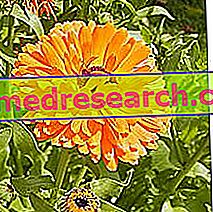Fire of saint Anthony
St Anthony's fire is an infection caused by the Herpes zoster virus (the same as varicella), which affects the nerve endings and the surrounding skin.

The main symptom is the typical vesicular and painful rash, which manifests itself with itchy blisters that contain viruses.
The fire of Saint Anthony is a sort of "relapse" of chickenpox: after recovery from this exanthematic disease, the Herpes zoster virus DOES NOT disappear, but hides (in silent form) in the nerve ganglia. During the course of life, any reactivations of the virus will give rise to the fire of St. Anthony.
Treatment - Drugs and Diet
There is no cure for the fire of Saint Anthony.
Treatment is aimed exclusively at alleviating symptoms pending spontaneous resolution.
It is advisable to cover the rashes with long but not adherent clothing. This avoids blistering by increasing pain and spreading viruses.
Furthermore, it is possible:
- Use anti-inflammatory drugs, such as: paracetamol, ibuprofen or codeine, to control pain.
- Use antiviral drugs to stop the replication of the virus (it is not always necessary).
- To learn more: St. Anthony's Fire Treatment Drugs
The beginning of the fire of Saint Anthony is not preventable. A vaccine called Zostavax is available on the market; however, this is not always effective.
Diet
Introduction
It is believed that by stimulating the tropism of the immune system it is possible to keep it effective and efficient in the fight against herpes zoster.
This "preventive method" is based on nutrition and physical activity (the latter, only preventive).
The system does not offer protection from infection and does not guarantee to avoid a relapse. However, it aims to achieve the best possible reaction of the physiological immune system.
Among the various nutritional molecules that can stimulate the immune system, the most important are:
- Vitamins, water-soluble and fat-soluble
- Zinc
- Isoflavones
- Supporters of intestinal bacterial flora.
Vitaminic Molecules
The fat-soluble vitamin D (calciferol) and the water-soluble vitamin C (ascorbic acid) are very important in dietary support for immune function. In short:
- Vitamin C: ascorbic acid is the molecule most involved in the fight against infections. It is a powerful antioxidant that, in the defense mechanism, acts especially in opposition to viral proliferation.
Foods rich in vitamin C are of vegetable origin. They belong to the VII fundamental group of foods; these are vegetables and fruits such as: chilli, bell pepper, parsley, citrus fruits, kiwi, apples, lettuce, broccoli, pumpkin, etc. Vitamin C remains damaged with cooking; for this reason, the diet for the fire of Saint Anthony is characterized by many vegetables and fruits in raw form .
- Vitamin D: it is shown that calciferol participates in the tropism of the immune system. Good dietary levels of calciferol are preventive against many infectious diseases (even viral).
Vitamin D is synthesized in the body at the skin level, thanks to the interaction with the UV rays of sunlight. It can be introduced with food; the foods that contain the most are fish and egg yolk.
It is believed that vitamin A (in the form of retinol and carotenoids) and vitamin E (tocopherols) have a positive effect on immune defense. These are two powerful antioxidants which, together with C, counteract the action of free radicals.
- Carotenoids (pro vitamins A) are typical of the food group VI; abound in: carrots, peppers, melon, apricots etc. Retinol, on the other hand, is particularly present in animal liver and in certain fishery products.
- Vitamin E is very concentrated in olives, oil seeds, wheat germ and related extraction oils.
Other Molecules
- Zinc: in some viral infections, zinc intake is effective in reducing the severity and time of illness. Some foods contain more than others; the richest are: oysters, liver, milk and meat. While vitamins and isoflavones (which we will read below) can be introduced sufficiently with food, the optimal zinc concentration may require the use of a food supplement.
- Isoflavones: are antioxidants of vegetable origin contained in soya, vegetables and fruits. Like vitamins A, C, E, and other types of antioxidants, they hinder the action of free radicals.
- Probiotics and prebiotics: probiotics are the bacteria naturally present in the intestine; prebiotics, on the other hand, are the molecules that feed them. Since there is a positive correlation between the intestinal bacterial flora and the efficiency of the immune system, some believe that the fire diet of St. Anthony must preserve the health of these microorganisms.
It is possible to increase the dietary share of probiotics by consuming fermented foods with: lactobacilli, bifidobacteria and eubacteria . Among these, the best known are: yogurt, kefir, buttermilk, kimchi, miso, gherkins and sauerkraut; the market also offers many diet foods and supplements / drugs that contain them. To "feed" these bacteria in the best way it is necessary that the diet of the fire of Saint Anthony is rich in soluble dietary fiber and carbohydrates, which play an excellent prebiotic function.
Furthermore, it would be advisable to reduce refined sugars, hydrogenated fats (instead harmful) and maintain a correct distribution of total proteins and lipids (to guarantee the right pH of the faeces).
Amino acid Arginine: is it harmful?
The amino acid arginine has always been considered a beneficial agent for the immune system.
However, according to "WholeHealth Chicago", arginine-rich foods tend to promote Herpes zoster virus growth.
Foods that, in addition to having a high arginine content, show a low lysine content are even more problematic. Also the latter is an amino acid; in the body, it performs the function of balancing the metabolism of arginine.
During St. Anthony's fire, foods that contain more arginine than average could be avoided; for example, they are not recommended:
- The oil seeds, especially peanuts, hazelnuts and almonds
- Legumes and derivatives, especially soy, broad beans, lentils and chickpeas.
On the contrary, foods with an optimal ratio of arginine / lysine should be preferred; for example: fish, poultry, beef and lamb. However, the portion of these foods must not be excessive.
Physical activity
Physical activity is another element that can positively affect the immune system.
By practicing motor activity with a medium-high commitment, it is possible to stimulate the natural defenses, pushing them to function optimally.
On the other hand, it should not be forgotten that the sporting activity carried out assiduously and at very high intensity could determine a diametrically opposite effect.
It is recommended to engage in a motor activity protocol characterized by a frequency of 3-4 weekly sessions, lasting 40-60 minutes each. The intensity should be adjusted in relation to the number and duration of the sessions.
Causes, Incidence and Complications
Normally, the immune system is able to keep herpes zoster under control and in silent form. Only in certain cases, this virus reactivates and evolves into a fire of St. Anthony.
In healthy people, the causes of the onset of fire of St. Anthony are not yet known.
Some argue that viral reactivation is attributable to a lowering of natural shields, which can occur:
- With old age (especially> 70 years)
- For psycho-physical stress
- For taking immunosuppressive drugs
- Because of infections that weaken the immune system (HIV).
The contagion of the fire of Saint Anthony can take place only when the organism that comes into contact with the virus has never suffered from chicken pox; in this case the organism will develop chickenpox and, once resolved, it will eventually develop the fire of St. Anthony in the future.
The fire of Saint Anthony is almost always manifested only once in a lifetime, but recurrences are not rare.
Herpes zoster affects ¼ of the world population, but the incidence of varicella and sant'Antonio fire are very different. For the latter, the chances of onset increase with age, while chickenpox is typical of childhood.
The fire of Saint Anthony lasts about 2-4 weeks; 1/5 of the subjects develop a post-herpetic pain neuralgia that lasts longer. Very rarely, if the infection affects the face, the visual and / or auditory functions may remain compromised.



